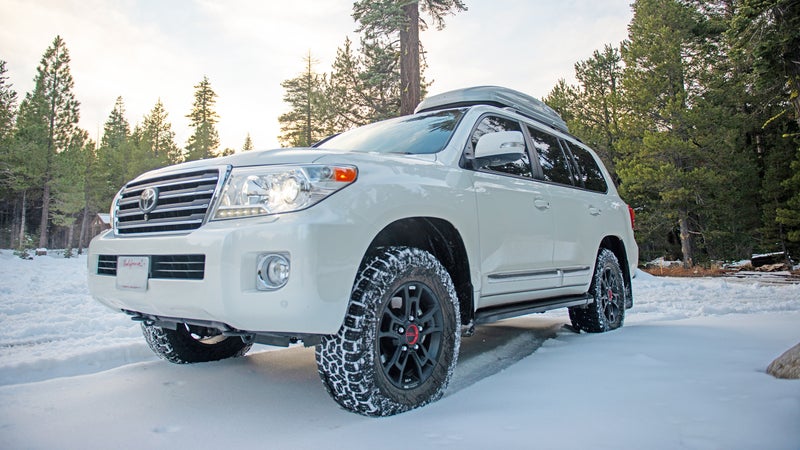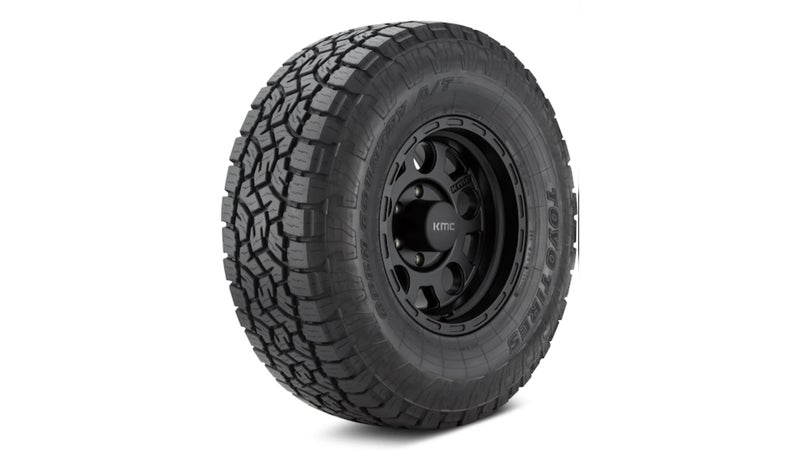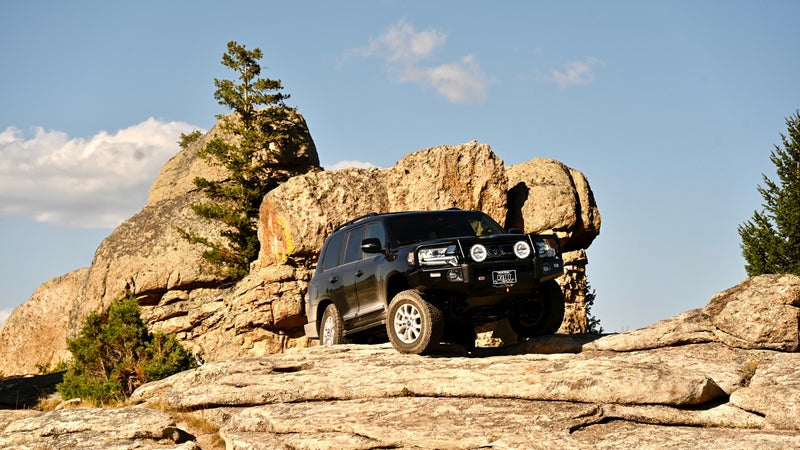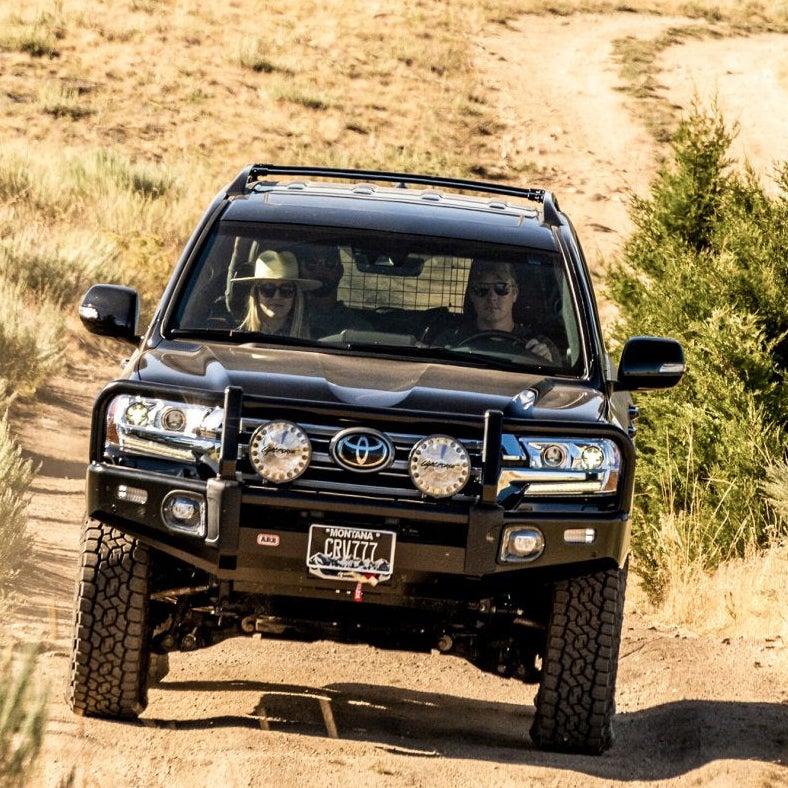If you want to take full advantage of the traction provided by your truckÔÇÖs four-wheel-drive system, you need to run a tire designed to grip the surfaces you drive on. And if those include both paved and unpaved roads, the tire youÔÇÖre looking for╠řis an all-terrain. Let me save you a bunch of money, hassle, and headaches, and show you how to find the right one for your specific needs.
What Is an All-Terrain Tire?╠ř
ÔÇťAn all-terrain tire is a jack of all trades, and a master of none,ÔÇŁ says Todd Bergeson, the senior manager of product planning at . Bergeson is responsible for engineering╠řthe tires my wife runs on her long-travel Land Cruiser,╠řand╠řhe participated in the design of that vehicleÔÇöbefore joining Toyo, Bergeson worked as an engineer and product planner at Toyota. His r├ęsum├ę also includes╠řother well-regarded 4x4s, like the 4Runner TRD Pro╠řand the FJ Cruiser.
What Bergeson is getting at is that,╠řwhile other tires may outperform all-terrains╠řon snow, dirt, or pavement, nothing else is designed to work as well across all those surfaces.
Compared with╠řa highway tire, an all-terrain tire will be equipped with a stronger bead (a ropelike ring that runs around the inner perimeter of the tire, holding it onto the wheel rim), tougher plies (the panels of steel or fabric mesh that lie under the rubber, adding strength and puncture resistance), as well as a rubber tread thatÔÇÖs thicker and designed to better withstand the cutting, tearing, and deformation caused by off-road surfaces. The pattern of that tread will also be designed to grip loose surfaces, while evacuating water, mud, small rocks, and snow as efficiently as possible.
Unfortunately, all those traits do come with some trade-offs. Compared with╠řa highway tire, an all-terrain tire will be heavier and louder╠řand wonÔÇÖt offer quite as much grip on pavement. Bergeson╠řsays╠řthat more new vehicles donÔÇÖt come╠řequipped with all-terrain tires for just those reasons. ÔÇťMost drivers donÔÇÖt actually use their 4x4s off-road,ÔÇŁ he says. ÔÇťAnd they still want their trucks to be competitive with other vehicles.ÔÇŁ
Consumers who buy rugged╠řSUVs╠řor pickups with the expectation╠řthat theyÔÇÖll╠řdrive like a luxury car or a sports car often dictate the tire choices made by car manufacturers. If you bought an SUV or a pickup truck╠řwith the expectation╠řthat youÔÇÖll be able to use it off-road╠řand in winter weather, youÔÇÖll need to change those tires.

WhatÔÇÖs the Right Size?
Larger tires will more easily roll over larger obstacles off-road. They also look cool. Unfortunately, larger tires will also reduce a vehicleÔÇÖs effective gear ratio. As I wrote about at length in an article about people ruining their Tacomas, that can utterly destroy a vehicleÔÇÖs fuel economy, performance, and off-road capability.
Want to see the effect that fitting a larger tire size will have on your vehicleÔÇÖs performance? .
(Original tire diameter) / (New tire diameter) x Vehicle axle ratio = Effective axle ratio with new tires
So╠řif youÔÇÖre switching from the 30.5-inch tire that comes standard on a Tacoma╠řto a 34-inch tire, given the TacoÔÇÖs 3.91 gears, that will give you a new effective ratio of 3.50 to 1. Your performance will decrease by 11 percent.
ItÔÇÖs hard to picture what that will look like in the real world, so╠řthis formula will help you understand that:
(Original tire diameter) / (New tire diameter) x RPM@MPH = New RPM at that speed
Again, using the same Taco example, switching from a 30.5-inch tire╠řto a 34-inch one╠řwill reduce engine revolutions at 60 miles per hour from 1,500 to 1,345 revolutions per minute. ThatÔÇÖs also an 11 percent difference. Take that into the real world and see how your engine and transmission perform at the different RPMs. Just remember that the effects of altering your final drive ratio with larger tires are compound; while your engine will be operating at lower RPMs╠řat a given road speed, it will also have less power.
Wondering how much height a taller tire will add? Fortunately, that calculation is a lot easier. Simply divide the difference in tire diameters by half, and that will give you the increase in height that changing the tires alone will give you. This can be important in determining whether or not your truck will fit in your garage.
What I canÔÇÖt give you a formula for is how well a larger tire will fit on your vehicle. For instance, mounting (which actually measure out at 33 inches) to my Ranger required a two-inch suspension lift, chopping off the wheel-crash bars, and using wheels that spaced the tires╠řoutboard. And they still rub at full lock in reverse. Every vehicle and every suspension setup will be different, and the skill of your alignment shop plays a role in tire fitment, too.
Does all that sound like a real pain in the butt? It is. There is no possible outcome here in which increasing your tire size does not cost you money╠řand create an unnecessary hassle. So╠řinstead of trying to fit a larger size when you switch to an all-terrain tire, IÔÇÖm going to make a controversial suggestion here: donÔÇÖt. The best╠řall-terrain size for you is almost certainly the tire size your vehicle left the showroom with.

What About Load Ratings?
And you thought sizes were complicated! All-terrain tires come in three varieties, based on the loads theyÔÇÖre designed to handle: P/Euro-metric, LT, and flotation.
A tireÔÇÖs load capacity is determined by how much air itÔÇÖs designed to hold. P/Euro-metric all-terrains come in either standard load (denoted by an SL or nothing in the tireÔÇÖs size description)╠řor extra load (XL in the size description). SL tires can be inflated to 36 pounds per square inch (psi), while XL tires can hold 42 psi.
In either case, you should look up your vehicleÔÇÖs gross vehicle weight rating (GVWR), found online, inside your doorjamb, or in your ownerÔÇÖs manual, and make sure any tire you fit is designed to support at least a quarter of that weight.
ÔÇťThink of a tire like a balloon,ÔÇŁ says Bergeson. One designed to hold less air can be made thinner and lighter. One designed to hold more will need to be thicker and heavier.
LT stands for light truck (youÔÇÖll see LT ahead of the tire size). In this verbiage, this denotes anything shy of a commercial vehicle. LT tires come standard on heavy-duty pickups, like the Ford Super Duty. The load capacity of LT tires is denoted by letters, typically B, C, D, E, or F. In the past, these letters indicated the number of plies used in the tireÔÇÖs constructionÔÇöin╠řthat same order: four, six, eight, ten, and twelve╠řplies. With modern materials, thatÔÇÖs no longer the case. High-strength steel, nylon, or polyester plies donÔÇÖt need to use as much material to provide an equivalent capacity to the cotton plies of yore, so tires now feature a ply equivalent rating. An E-rated tire, for instance, can now hold as much air as ten old plies, using just three plies made from modern materials. All you need to understand is that B-load tires can hold the least air, and therefore support the least weight, and that progresses on up to F, which can hold the most air╠řand therefore support the most weight.
As a tireÔÇÖs load capacity increases, so does the air pressure it takes to fully inflate it. Where the maximum pressure on a standard-load P/Euro-metric tire is 36 psi╠ř(consult the table inside your vehicleÔÇÖs doorjamb for recommended pressures;╠řtheyÔÇÖre typically a little lower than the maximum), the max pressure for an E-rated LT tire is probably 80 psi.╠ř(On LTs, maximum pressures vary with tire size.╠řIÔÇÖm glossing over some technicalities for brevity.)╠řNot only will that be a thicker, stronger balloon, but inflated to sufficient pressures, itÔÇÖll also be a stiffer one. On the road, youÔÇÖll feel that. The thicker, stronger╠řcarcass of an LT tire, inflated to a higher pressure,╠řwill deform less over small bumps than a P/Euro-metric one, transmitting those movements to the suspension. And not only will more bumps reach the suspension, the momentum of that heavier tire will also be greater, so those bumps will effect the suspension more severely. It also takes more energy to accelerate or decelerate a heavier tire. All that╠řto say: compared with╠řa lighter P/Euro-metric tire, a heavier LT tire will worsen your vehicleÔÇÖs ride quality, make it slower, and increase your braking distances.
ItÔÇÖs important to emphasize here that╠řif you upgrade from the P/Euro-metric highway tires that likely came with your vehicle to an aftermarket LT tire, youÔÇÖll need to run higher pressures than is suggested by your vehicle manufacturer on the road. LT tires require more air╠řto reach optimal levels of inflation; fail to inflate one fully and the tireÔÇÖs tread will cup inward╠řrather than make uniform contact with the road. This will cause your tires to wear prematurely and create an awful lot of noise, and that reduced contact patch will combine with the soft, underinflated sidewalls to entirely ruin your vehicleÔÇÖs handling. to determine the correct pressures for your LT tires.
But╠řcarcass strength isnÔÇÖt the only thing separating P/Euro-metric all-terrains from LT ones. Bergeson╠řsays╠řthat Toyo uses different compound materials for the two categories of tires, as well as╠řdifferent tread designs.
ÔÇťOur data says P/Euro-metric users spend at least 80 percent of their time on paved roads,ÔÇŁ he says. So Toyo optimizes those tires for that use. On its new , for instance, Toyo employs a rubber compound with a higher proportion of silica, which enhances grip on wet pavement. And╠řthe tread pattern features smaller voids╠řand more siping. (Sipes are the squiggly little lines inside the tread blocks.) The noise you hear all-terrain tires make is created by air passing through those voids. So making sipes╠řsmaller on tires biased to╠řon-road use helps make those tires more civilized. Sipes enhance mechanical keying on slippery surfaces like ice, so adding more of them helps the P/Euro-metric AT/IIIs perform better in winter conditions.
I asked Bergeson if the thinner, more flexible construction of a P/Euro-metric tire was less suitable for off-road use. ÔÇťYouÔÇÖll actually find that the more flexible tire deforms better over obstacles, which can help with grip and ride quality,ÔÇŁ he says. ItÔÇÖs not true that plies used in those tires can lead to more punctures. While the strands used to construct the lighter tires arenÔÇÖt quite as thick, theyÔÇÖre more densely woven, which works to prevent penetration equally well. The one area where an LT tire might be more resistant to punctures than the lighter option will come simply from increased thickness of the tread on the former.
Where a P/Euro-metric AT/III is equipped with a tread depth of 13/32nds of an inch, the tread on LT sizes is 16/32nds of an inch deep. That means the rubber that the LT tires drive on is that much thicker. ItÔÇÖs also made from a different compound, with a lower silica content, and uses a tread pattern with larger voids╠řand fewer sipes. Bergeson says that these changes are intended to increase the LT tireÔÇÖs durability and performance off-road. Not only is the lower-silica-content compound more resistant to cuts, tears, and deformation caused by sharp rocks, but the larger voids are better at ejecting those rocks before they can cause damage. Fewer sipes are also less prone to picking up╠řand being damaged by very small stones. With fewer of those sipes, the tread blocks on LT AT/IIIs better resist deformation, which restores some of the steering feel and stability lost by the larger voids. But╠řthose larger voids╠řenhance traction on loose surfaces like mud.
Notably, equipping LT tires with the ability to contain higher air pressures also gives them one feature that really helps off-road: because all that extra air requires a thicker, stronger bead, LT tires mount more securely to their wheel rims. This lets drivers safely run lower pressures off-road.
Which brings us to flotation sizes. Whereas P/Euro-metric and LT sizes are listed in metric sizes (285/75R17 for instance), flotation sizes are listed in imperial specs (35×12.5R17). TheyÔÇÖre typically produced in loads ranging from C to E╠řand are usually available only in wider widths. Flotation tires are the most off-road-oriented all-terrains. Flotation AT/IIIs, for example, use a 17/32nds╠řtread depth╠řand even larger voids than the equivalent LTs. So╠řthey also require high on-road pressures╠řbut will be even more durable off-road, and even noisier on. Because theyÔÇÖre so wide, flotation sizes typically only fit modified trucks.
Running P/Euro-metric all-terrains in your vehicleÔÇÖs stock tire size is the easiest, most effective way to gain traction off-road and in winter weather╠řwithout sacrificing too much in the way of road manners. Bergeson recommends only upgrading to an LT tire if you drive a lot of gravel (or if the weight of your vehicle dictates it). All the tiny, sharp, rolling rocks in that surface represent a unique challenge to tires, and itÔÇÖs one the compound╠řand voids used on the LT AT/IIIs are╠řspecifically designed to handle.

What Are the Best All-Terrain Tires for You?
Beyond size and load capacities, there are╠řa couple other markings you need to consider.
Dial in the Mud and Snow Factor
The first of those is the M+S stamp thatÔÇÖs present on most all-terrain tires╠řand also many highway tires that advertise themselves as appropriate for mud and snow. The M+S standard is ╠řand is self-reported by tire makers, not certified by any independent body. To merit this stamp, a two-dimensional analysis of a tireÔÇÖs tread pattern must demonstrate that at least 25 percent of the treadÔÇÖs surface area is made up of grooves. M+S reflects no actual designed, intended, or tested traction in mud or snow, just that 25 percent groove area. DonÔÇÖt rely on an M+S stamp to tell you anything about a tireÔÇÖs performance.
Conversely, the 3 Peak Mountain Snowflake (3PMSF)╠řdoes ╠řto an actual American Society for Testing and Materials standard, but it is still self-reported by tire makers. And while 3PMSF is used by authorities to legally define a winter-capable tire, thatÔÇÖs a very limited standard. To score╠řa 3PMSF rating, a tire only has to demonstrate traction on packed snow thatÔÇÖs 10╠řpercent superior to a reference tire, that reference tire being a bargain-basement highway all-season tire from the early 1990s. Running a 3PMSF stamp may allow you to legally drive into Lake Tahoe, California,╠řin the winter in a four-wheel-drive vehicle without snow chains, but it does nothing to guarantee that your drive will be safe.
Until such a time that adequate performance standards for tires are enacted, we as consumers have to work with╠řtire-maker claims, customer reviews, and independent tests conducted by enthusiast publications. If that doesnÔÇÖt sound like an ideal situation for finding objective guidance around choosing the single most important component on your vehicle, IÔÇÖm with you.
How I Pick the Best All-Terrain Tires
My method for picking an all-terrain tire is to first figure out what size and load capacity I need, then to look around for the tire with those╠řnumbers that has╠řbeen developed most recently. Assuming that materials and manufacturing technologies advance over time, I figure that should result in the latest and greatest product. But╠řjust to be sure, IÔÇÖll pull up a tireÔÇÖs╠řspecs╠řand compare them with competitors. The point of comparison thatÔÇÖs most important? Weight. For all the reasons described above, a lighter tire is a better tire╠řif it otherwise provides the load capacity, durability, and traction you require.
And thatÔÇÖs how I ended up putting on my wifeÔÇÖs Land Cruiser. That tire was released last March, and in the LT275/70R18 E size╠řthat╠řworks best with the very complicated custom-suspension system on that truck,╠řthe 53-pound AT/III is four pounds lighter than the ÔÇöand over seven pounds lighter than the .
ÔÇťBecause we manufacturer the tire in America, weÔÇÖre able to very carefully place rubber only where itÔÇÖs needed,ÔÇŁ said Bergeson╠řwhen I asked him to account for that weight difference. He went on to explain that the AT/IIIÔÇÖs light weight is achieved without sacrificing puncture resistance. Tread depth isnÔÇÖt compromised on the design.╠řPlus,╠řthe unique method by which the company layers its plies ensures that, while the E-rated AT/III is technically a three-ply tire, the plies overlap behind the tireÔÇÖs sidewall, effectively protecting that area with six plies, while helping the tire retain better stability on the road.
Those merits have been╠řborne out in my time driving on those tires. That theyÔÇÖve proven trouble-free off-road should be expected. WhatÔÇÖs surprising is how good they are╠řon dry pavement, on the road in rain, and on packed snow, too. Since we live in Montana, I still switch╠řto a dedicated winter tire for that season, but running the AT/IIIs in the shoulder seasons allows us to confidently tackle even significant snow events without concern.
My one prior╠řfrustration with that vehicle had been how invasive╠řand lurch-prone its traction-management system is. But╠řthe level of grip provided by the AT/IIIs has smoothed it out╠řand made it more effective╠řand seamless in operation. I had no idea when I selected╠řthe tires that they were engineered by one of the guys who helped develop the Land Cruiser, but now that I know, itÔÇÖs not a huge surprise that theyÔÇÖre the perfect match for the vehicle.
The Bottom Line: Best All-Terrain Tires
What are the best all-terrain tires for you? Run through the formulas I listed above to determine the right size.╠řThen╠řdecide whether or not your use case is more on-road╠řor off, and choose either P/Euro-metric or LT tires to suit. (Consider a flotation size if you drive a highly modified truck.) See if you can find a lighter tire than the AT/III, and if you canÔÇÖt, run those. DonÔÇÖt be surprised if those tires make your truck feel brand-new, too.
(If you drive an all-wheel-drive crossover, I still recommend the . ItÔÇÖs the only all-terrain tire actually designed to work on Subarus╠řand the like.)


